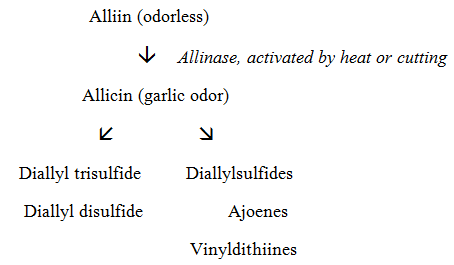 About Authors:
About Authors:
Sharma Monish*, Kumar Bhupender
Seth G.L Bihani S. D. College of Technical Education,
Institute of Pharmaceutical Sciences & Drug Research.
Sri Ganganagar, Rajasthan (INDIA)
*monish28sharma@gmail.com
Introduction :
The name “Allium sativum” is derived from the Celtic word “all”, meaning burning or stinging, and the Latin “sativum” meaning planted or cultivated. The English word, garlic, is derived from the Anglo-Saxon “gar-leac” or spear plant, referring to its flowering stalk.(Kemper J Kathi.2000)
Garlic (Allium sativum), a member of the Liliaceae family, is a common food for flavour and spice and it is one of the herbs most commonly used in modernfolkloric medicine. Garlic was an important medicine to theancient Egyptians as listed in the medical text Codex Ebers(ca.1550 BC) especially for the working class involved in heavy labour because it was an effective remedy for many aliments such as heart problems, headache, bites, worms and tumours. In 1858, Pasteur noted garlic’s antibacterial activity, and it was used as an antiseptic to prevent gangrene during World War I and World War II. (Thomson Martha.et.al.2007, Tattelman Ellen.2005)
[adsense:336x280:8701650588]
REFERENCE ID: PHARMATUTOR-ART-1682
According to the US Food and Drug Administration survey of 900 People, garlic stands as the second most utilized supplement. In addition to its reputation as a healthy food , Garlic has shown anti-viral, anti-bacterial, antifungal, antioxidant , anti-atherosclerotic and anti-cancer properties. (Bongiorno B.Peter 2008)
Botany
Medicinal species: Allium sativum
Common names (Synonyms):Garlic(Eng.), lasun (Hindi), Rasonam & Lahsuna(Sanskrit), Russian penicillin, , Knoblauch (Ger), Knoblauchzweibel (Ger), da suan (Chin), taisan (Jap), inniku (Jap), taesan (Kor), tafanuwa (Hausa), ayo-ishi (Igbo), kitunguusumu (Swahili), ayu (Yoruba), , lobha (Nepalese)
Botanical family: Liliaceae/Alliaceae/Amaryllidaceae

[FIGURE : Allium sativum L. ](Wheatley A.Gacia 2010)
Plant description: Garlic is a bulbous perennial herb, closely related to the onion. It has a tall, erect flowering stem that reaches 2-3 feet in height. The plant has pink or purple flowers that bloom in mid to late summer. The part used medicinally is the bulb. European standards specify that garlic supplements contain not less than 0.45% allicin.
Geographical Source :Central Asia, Southern Europe, USA, India
Chemistry : It contains a wealth of sulphur compuds; most important for the taste is Allicin , which is produced enzymatically from allin. It also contain 65% water, 28% carbohydrate, 2.3% organosulphur compound ,2% proteins, 1.2% Free amino acid (mainly arginine), 1.5% fiber, 0.15% lipids, 0.08% phytic acid, 0.07%saponins.
Alliin metabolism : (Wubneh Helmae )


Pharmacological Study :S-allyl cystein sulfoxide (SACS), the precursor of Allicin and garlic oil, is a sulphur containing amino acid , which are believed to account for most of its medicinal properties i.e, controlled lipid peroxidation better than Glibenclamide and Insulin . It also improved diabetic conditions. SACS also stimulated in vitro insulin secretion from beta cells isolated from normal rats. (Kemper J.Kathi.2000, Harde Pinal et.al.2012)
Anti- diabetic effects – The component Allicin increases hepatic metabolism increases the release of insulin. It exhibits Insulin sparing effect by competing with the insulin activating compound as a result more insulin becomes free to act and exert greater antidiabetic effects. (Wheatley A.Gacia 2010)
[adsense:468x15:2204050025]
Garlic: Potential Clinical Benefits
• Cardiovascular: Antilipemic, antihhypertensive, anti-atherosclerotic
• Gastrointestinal/hepatic: Spasmolytic, hepatoprotective
• Endocrine: Hypoglycemic
• Hematologic: Antithrombotic/antiplatelet
• Reproductive: Emmenagogue/abortifacient
• Immune modulation: Immunostimulant
• Antimicrobial: Antiviral, antibacterial, antifungal, antiparasitic
• Antineoplastic: Chemoprevention
• Antioxidant: Antioxidant
• Other/miscellaneous: Anti-vampire .
• Rheumatologic: none
• Pulmonary: none
• Neuro-psychiatric: none
• Skin and mucus membranes: none
• Renal and electrolyte balance: none (Kemper J.Kathi.2000)
Garlic Supplements/ Preparations :
· Essentional oil ( Garlic oil)
· Dehydrated powder (Garlic Powder)
· Pills
· Oil macerate
· Extract (Roy Heli et.al.2005 ,Eidi A. et.al.2006)
REFERENCES
1. Kemper J, Kathi.(2000) Garlic (Allium stivum) . The Longwood Herbal Task Force-The center for Holistic Pediatric Education and Research. March 8,pp. 36-72.
2. Thomson, Martha.et.al.(2007) Anti-diabetic and hypolipidaaemic properties of Garlic (Allium sativum) in strepozotocin induced diabetic rats. International Journal of Diabetes & Metabolism. (15), pp.108-115 .
3. Tattelman , Ellen.(2005) Health effects of Garlic. Complementary and Alternative medicine. 72(1) , pp.103-106.
4. Bongiorno ,B.Peter (2008) Potential Health Benefits of Garlic (Allium Sativum): A Narrative Review. Journal of Complementary and Integrative Medicine5(1), pp. 1-26.
5. Wheatley A.Gacia (2010) Health Professionals knowledge of Allium sativum (Garlic).pp. 1-8.
6. Harde Pinal et.al.(2012) Antidiabetic Herbal drugs-A Review. Pharmacophore-An International Research Journal.3(1); pp. 18-22.
7. Roy Heli et.al.(2005) Health Benefits of Garlic. Pennington Nutrition series,pp. 1-4.
8. Eidi, A. Et.al.(2006) Antidiabetic effect of garlic ( Allium sativum L.) in normal and streptozotocin induced diabetic rats. Phytomedicine- Elsevier. (13), pp.624-629.
9. Wubneh Helmae. Properties and Synthesis of Allicin (Garlic). Coedpa ges. uncc.edu/.../Helmae%20Wubneh-Garlic.doc-United States.[Accessed on 09/07/2012]
NOW YOU CAN ALSO PUBLISH YOUR ARTICLE ONLINE.
SUBMIT YOUR ARTICLE/PROJECT AT articles@pharmatutor.org
Subscribe to Pharmatutor Alerts by Email
FIND OUT MORE ARTICLES AT OUR DATABASE









